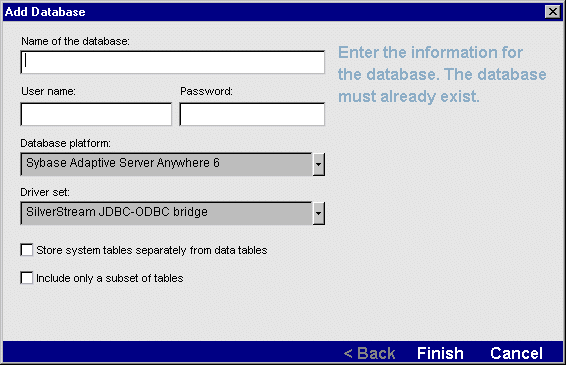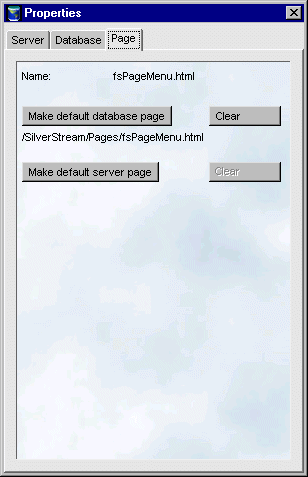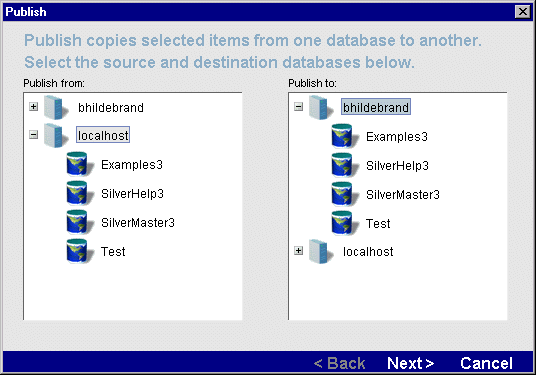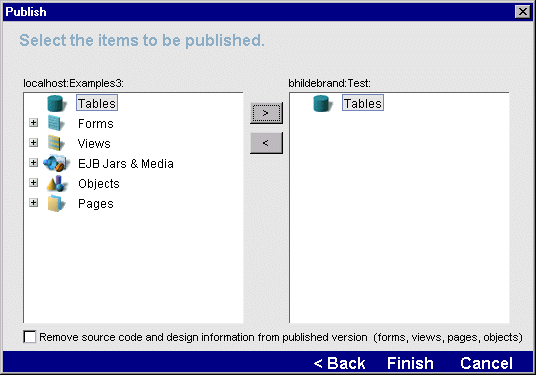



The SilverStream Main Designer is the jumping-off point for accessing the other Designers that enable you to create forms, views, tables, Web pages, business objects, and supporting files.
This page describes the following:


You can log in from the Main Designer.
 For information on providing user name and password, see the Security chapter in the Administrator's Guide.
For information on providing user name and password, see the Security chapter in the Administrator's Guide.

You can configure your SilverStream development environment in the following ways:
The Preferences dialog appears.

Specify General preferences as follows.
Specifies the browser to use when running pages from within the Designer. By default, SilverStream lists your default browser. To choose a different browser, change the pathname to the appropriate browser either by typing or the path or clicking Browse and selecting the browser. | |
Select this check box if you want to save your Designer console log in a file. If you select this option, specify the file to save the log in. The Designer console log contains the same information as the Java console, plus information specific to the Designer.
| |
Specifies whether you want SilverStream to access help from your local file system or from a database. NOTE Running help from a database is available only in Windows. In Windows, you can run the SilverStream help system in a Sybase Adaptive Server Anywhere database on the server. This gives you full-text search using the Fulcrum engine. Or you can run help from files in your local file system (with no full-text search). By default, the help database is installed and used. You can choose not to install the help database (for example, to save disk space) or not to install the help files (for example, if you will be running help only from the database). If you did install the help database (and installed Sybase Adaptive Server Anywhere), you can specify here whether you want SilverStream to access help through the database (SilverHelp3) on a server or through the file system (a directory structure in the SilverStream installation directory on your local machine). If you choose to use the help system from a database, specify a server name (by default, it is the local machine). |

Specify Compiler preferences as follows:
Directory containing the compiler. Change the directory if you are not using the default compiler. | |
Arguments you want passed to the compiler (such as -verbose). See your compiler documentation for more information. | |
If checked, debugging information will be included in the compiled Java code. | |
Directory containing the compile cache.
|

Specify Editor preferences as follows:
Name of font to use in the SilverStream Programming Editor and Business Object Designer. | |
Size of font to use in the SilverStream Programming Editor and Business Object Designer. | |
Style of font to use in the SilverStream Programming Editor and Business Object Designer. | |
Select Simple actions to have the Form Wizard generate simple actions. You can use simple actions to simplify your coding. Select Java code to have the Form Wizard generate only the actual Java code. If you select this option, you cannot use simple actions in forms (that is, you can work only in Java mode in the Programming Editor).
NOTE Regardless of the setting you choose here, the underlying generated code is the same. | |
Command line that SilverStream issues when you invoke an external editor from the Programming Editor or Business Object Designer. NOTE If you invoke an external editor and have not specified a command line here, the file will be opened in whatever editor is specified for the .JAVA file type in the Windows Explorer. |

When you start the SilverStream Designer, a list of registered SilverStream servers appears. To see a list of databases that reside on a server, select the plus sign (+) that appears to the left of the server icon. The SilverMaster database should appear. It contains data used by all the SilverStream applications that reside on that server.
If you want to use a database of your own, you must tell SilverStream what database to use. (For information about setting up database accounts, see the Installation Guide.) You also have the option of storing the system tables that SilverStream creates in a separate database from tables you have created (the system tables contain the objects that comprise your SilverStream application, such as the pages and business objects).
 To set up an existing database for use with SilverStream:
To set up an existing database for use with SilverStream:
A dialog box displays, prompting you to enter information about the database.

For an ODBC database, the database name must be an already existing ODBC data source name. If you are using non-ODBC access, see the Driver set field below. | |
Enter a user name and password pair that the SilverStream Server can use for a database user connection to your native database. These values cannot be null. This user name must already be known to the native database and have the appropriate read/write permissions. NOTE Your administrator should have defined a unique "user" for each application database (all users can have the same password). For more information, see Setting up a supported database in the Administrator's Guide. | |
Choose the driver set to use from the list (a driver set is a combination of a JDBC driver and SilverStream-specific files). The listed driver sets are specific to the database platform you selected. The driver set recommended for your database type is displayed by default. If you select a non-SilverStream driver set (that is, a driver set whose name does not begin with SilverStream), then see Using non-SilverStream driver sets. | |
If you plan to use a production database that other applications access, you may not want to add SilverStream system tables to it. This option allows you to store the SilverStream system tables in another database. If you check this option and click Next a dialog displays asking you to name the system table database. (This database must already exist.) | |
You might not want to use all the tables in the database you are adding. By selecting this option, you can specify a subset of tables to make available on the server. If you select this option and click Next, a dialog displays with two list boxes. In the top box, you can manually name each table you want to use. In the lower box, you can specify patterns to indicate sets of tables. For example, you could specify cust% to use all tables starting with cust. Click Next to continue. You will be shown which tables are no longer available and which are. Make any changes you want and click Finish. You can later change which tables are available:
|
What happens
When you add a database, SilverStream adds an entry in the SilverMaster database and also adds SilverStream system tables to your database (unless you specified to keep system tables separate from your data, in which case, the system tables are added to the other database).
Storing system tables separately from the data
If you are storing the SilverStream system tables separately from the data, SilverStream will store all the application components (such as pages, forms, and business objects) in the specified system database. However, you work with the application database as if the objects were being stored in it. You use the Designer to open and save objects from within the application database. The system database doesn't display in the Designer. The Designer lists all the application objects as if they were stored in the application database, even though they are stored in the separate system database.
Adding a database from the command line
You can also add a database to the server from the command line or from a batch file. For more information, see SilverCmd Reference.
If you are not using a SilverStream driver set, you must supply additional information.
The following describes each of the fields on this dialog.
 See your JDBC driver documentation for more details.
See your JDBC driver documentation for more details.

If you don't need to maintain a connection between a database and the SilverStream Server (for example, you have gone through the tutorial and no longer need to use the tutorial database), you can remove the connection.
 To remove a database connection with the server:
To remove a database connection with the server:
What happens
When you remove a database connection from the server, SilverStream removed the entry from SilverMaster but leaves the database itself fully intact (including the SilverStream system tables).

 For more information, see the chapter about your DBMS in the Installation Guide.
For more information, see the chapter about your DBMS in the Installation Guide.

You can use the Main Designer to connect to additional SilverStream servers and/or to establish a secure connection to a SilverStream server.
 To connect to a SilverStream server:
To connect to a SilverStream server:
The SilverStream Designer dialog displays, prompting you to enter the name of the new server.
Establishing a secure connection By default, all communication between the Designer and the server is unsecured. If the server you are connecting to is listening on the DSA port, you can create a secure (encrypted) connection to the server by specifying the following for the server:
https://server:DSA_port
The default DSA port is 444.
 For more information, see Establishing a secure connection to the server in the security chapter in the Administrator's Guide.
For more information, see Establishing a secure connection to the server in the security chapter in the Administrator's Guide.
What happens
A new server icon appears in the left pane of the main window. This icon displays the name of the server you selected. To see a list of databases that reside on the server, select the plus (+) sign that appears in front of the icon.

 To shut down or restart the server:
To shut down or restart the server:
The Shut down or Restart dialog displays.
What happens next depends on whether you selected Deactivate server first.
 For information on programmatically handling server deactivation, see the chapter on server-triggered business objects in the Programmer's Guide.
For information on programmatically handling server deactivation, see the chapter on server-triggered business objects in the Programmer's Guide.

You use the Main Designer and the other designers to create, save, rename, and delete objects, such as forms and pages.
The object is saved in the database and listed in the Main Designer.
NOTE If in Step 2 you specify the name of an existing object of the same type, but specify a different combination of upper- and lowercase letters, you will receive an error due to Java's case sensitivity. Go to the Main Designer, delete the existing object, then save the new object.
You are asked to confirm the deletion.
The object is permanently deleted.

You can specify a default page for a database or for a server.
 To set server or database default pages:
To set server or database default pages:
The page will be displayed if the user specifies the URL for the database. | |
The page will be displayed if the user specifies the URL for the server. |

The default pages can also be set or cleared from the Server and Database tabs in the Property Inspector.
The Main Designer shows the default server page and default database page using a house icon.

SilverStream provides two consoles that you can use to help debug your application.
Used for server-side debugging. Displays the following:
NOTE This console shows the same information as the window that opens when you start the server (if the server is not started as a service). The advantage of opening the Server Console from the Designer is that you can easily save the output in a file.
| |
The Server Console displays http://server-name/ in its title bar. The Java Console displays Console in its title bar.

A SilverStream database consists of your existing database tables plus SilverStream system tables. The SilverStream system tables are ordinary database tables that are either added to your application database or are stored in a separate database. They can be backed up like any other table in your database using your DBMS's backup utility.

SilverStream stores all application information (including SilverStream metadata such as forms, views, and scripts) in the database, so you can use the standard replication features of your DBMS to upgrade and maintain replica copies. Replication involves duplication and distribution. It's important to make sure your data and structure remain in synch with each other.
 See your DBMS documentation for details.
See your DBMS documentation for details.

You can use Publish to copy objects from one database to another. For example, you can use Publish to copy your application from a development server to a production server. You can copy an entire database or selected objects.
 For more information about publishing objects, including issues that can arise when publishing, see the deployment chapter in the Programmer's Guide.
For more information about publishing objects, including issues that can arise when publishing, see the deployment chapter in the Programmer's Guide.
 To publish objects from one database to another:
To publish objects from one database to another:


If you want to publish the database schema, highlight Tables and add it to the Publish To list. Publishing the tables schema is an all-or-nothing choice; you cannot select individual tables.
NOTE Publishing tables does not copy table data or elements that the SilverStream Designer can't build. For example, it doesn't copy indexes or stored procedures from the source database to the destination database.
For example, say you are creating a SilverStream application for a customer. You want to give them the compiled application but you do not want to include the source code because it contains trade secrets in the form of special code and your own comments. By default, SilverStream publishes both the compiled binary form of the application and the Java source code. Check this box to publish only the compiled form of the application.
A message appears warning you that similar objects that already exist in the destination database could be overwritten.
If you are publishing tables, the Table Changes list box appears. It lists the table modifications (if any) that will be made.
SilverStream displays a messsage box when the publishing is complete.

The SilverStream Server supports the use of JavaBeans, Enterprise JavaBeans, image files, sound files, and other objects in your applications. These items are maintained in the SilverStream Media Store.
You can add or delete items from the Media Store by accessing the Media Store from the SilverStream Designer or by using the ImportMedia or Delete SilverCmd.
NOTE Use ImportMedia to import multiple files at once (with the Designer, you can only import one file at a time).
You can also export items from the Media Store to disk with the PublishToFile SilverCmd.
 For more information about SilverCmd, see the
SilverCmd Reference.
For more information about SilverCmd, see the
SilverCmd Reference.
 To use the Media Store with the Designer:
To use the Media Store with the Designer:
A pop-up menu displays.

You can use the Property Inspector to view the properties for objects contained in a selected database.
 For more information about properties, see About Properties and Events in the Property and Event Reference.
For more information about properties, see About Properties and Events in the Property and Event Reference.
 To use the Property Inspector:
To use the Property Inspector:
The Property Inspector dialog box displays. It contains information about the object.

Use the Build command to compile code for:
Whenever you do a Get from Source Control, you should use the Build command to compile the code.
Note that Build does not resave the SilverStream object. It simply compiles the existing source.
The Build dialog box appears. It contains information about the specific items that are being compiled. It also displays any compile errors or warnings that might be generated.

You can place your SilverStream objects under source control using the Main Designer.
 For more information, see
SilverStream Source Control.
For more information, see
SilverStream Source Control.